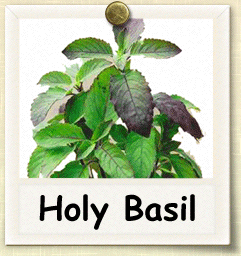Ocimum tenuiflorum, also known as Ocimum sanctum, holy basil, or tulasi or tulsi (also sometimes spelled thulasi), is an aromatic plant in the family Lamiaceae which is native to the Indian subcontinent and widespread as a cultivated plant
throughout the Southeast Asian tropics. It is an erect, many-branched subshrub, 30–60 cm (12–24 in) tall with hairy stems and simple phyllotaxic green or purple leaves that are strongly scented.Leaves have petioles and are ovate,
up to 5 cm (2.0 in) long, usually slightly toothed. The flowers are purplish in elongate racemes in close whorls. The two main morphotypes cultivated in India and Nepal are green-leaved (Sri or Lakshmi tulasi) and purple-leaved (Krishna tulasi).
Tulasi is cultivated for religious and medicinal purposes, and for its essential oil. It is widely known across the Indian subcontinent as a medicinal plant and a herbal tea, commonly used in Ayurveda, and has an important role within
the Vaishnava tradition of Hinduism, in which devotees perform worship involving holy basil plants or leaves. This plant is revered as an elixir of life.The variety of Ocimum tenuiflorum used in Thai cuisine is referred to as Thai holy basil
it is not to be confused with Thai basil, which is a variety of Ocimum basilicum.
Bamboo typically grows in 6-8 months.Pepal tree needs typically
30 years to grow.But Tulasi can grow in just 4 weeks
.Tulasi gives oxygen for 20 hours and gives ozone for 4 hours.It is used in ayurveda for medicinal purposes.
There is a succesful initiative by nasa that
they germinated tulasi in moon.
Tulasi is a medicinal and a Global Warming 24 carbondioxide absorber .
There is a proverb an apple a day keeps a doctor away but 4 Tulasi leaves a day keeps a Apple away.






